|
|
Chef Gabriela Green; Hierbabuena- Cocina Mobile Gourmet
If you are a good robber, no one will think you are a thief; you are a new creator.
|
| Gaby's food is delicious and so is her personality. You could just eat her up. The more you chew, the more flavors there are. Her dishes and her person have great depths; spicy, sweet, substantial, delightful, nutritious; good for you on levels you didn't even know were there.
Gaby is an eclectic connoisseur, not just of cuisine, but of life. She is a world traveler, who has returned home to her grandmother's Mexican kitchen with the smells and tastes of Spain, Italy and beyond. Her prominent career in Mexico cinema brought her in touch with a broad range of cultures throughout Europe and the USA.
Gaby is a philosopher, a wise-woman, who has fashioned out of the notoriously harsh world of restauranting a sustainable, healthy niche for herself. As she blends cuisines into her own unique offerings, so she has taken, from various walks of life, principles that work for her, arranging her schedule to allow time to pursue her varied interests. In keeping with the notion that the chef's mood is transmitted into the food, I've always said, "You need to keep the cook happy." Gaby keeps herself that way.
Gaby, who started her professional life as a kindergarten teacher, is once again educating children; this time their palates. Her food-truck, Hierbabuena- Cocina Mobile Gourmet is parked Monday, Wednesday and Friday 10-4 on Stirling Dickinson right across from the new Academia Internacional. The kids (and teachers and parents) come over after school adding to her already diverse clientele. The festive gathering of diners nourishing themselves under her awnings would warm any restaurateur's heart.
I first met Gaby because I was substitute dog-sitting for her, taking my daughter's usual position. The three 15 year old dogs were all from the same litter. They were young for their years, sustained by Gaby's special cuisine and love. Something of a restaurateur myself, I fell in love with Gaby's well-stocked kitchen. I thoroughly enjoyed concocting dishes from her larder of herbs and delicacies. But she is the one who really brings it all home, from her heart to your plate.
- Dr Dave (Fialkoff) |
| |
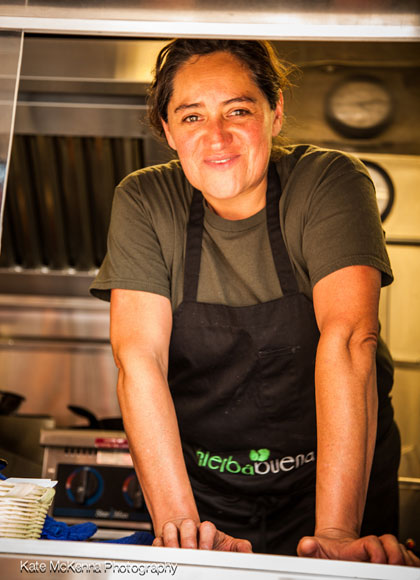
photo by Kate McKenna
|
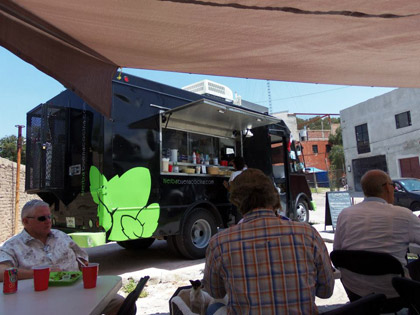
photo by George Bowers
|
|
This is a barely edited transcription of a loose conversation. I reassured Gaby that it's all very tasty. Provecho!
***
I was interested in food always. My main memory of my Mexican grandmother is that I used to go after school to her house. She had 13 kids and my mom is the eldest. My uncles and aunts were like my brothers and sisters, because of our similarity in ages. I remember the feeling and flavor, the memory of the red rice cooking, the Mexican rice, coming into the house while she was making the rice.
And I had my own banquito (little stool) and I would get back from school, take my bag off, wash my hands. I called her "Mama," "What are you cooking Mama? It smells great. It's rice!"
My grandmother was a beautiful, imaginative, creative person, so while she was cooking she'd play the piano and sing so it was a great scene between cooking in the kitchen and playing the piano. They were golden years of Mexican culture. I have that memory.
My first profession was a kindergarten teacher. Then I went to art school; I like art and painting. Then I started to travel.
|
|
In these travels I found my interest in ingredients and smells. I was very good friends with the mother of a friend from Spain and so I spent a lot of time cooking and learning Spanish cuisine with her. Never thinking about the future, just in that moment it was my interest. And then I had a partner that was from Italy and I learned to make pasta and all the sauces. I learned these two cuisines, Spanish and Italian in a close relationship with these two people and the countries.
And then on my other side I have my roots in the European Jewish community. I wasn't that familiar with that community and tradition, because I never really spent time with my Jewish grandmother in the kitchen, but I was always curious, "how is that kitchen? how is that cuisine?" So I tried to find recipes and things and much later I started to put together Jewish cooking with Mexican cooking. Then, trying to make my own thing, that becomes interesting because Pre-Hispanic cooking is vegetarian, without meat, which is almost kosher in a way. And so sometimes I make an old Jewish recipe with a Pre-Hispanic recipe and it works perfectly and people like it. They don't know where it comes from, but they love it.
It's an evolution. Food is changing in the world. The concept of food, the concept of freshness. For example, right now we have the organic and the not organic, or seeds that we use now we haven't used in the past 200 years. Then you find out it is some old seed from Mesoamerica, from 500 years ago that was cultivated by the Spaniards. They stopped the cultivation and today people think things like quinoa are new but they are not, they are a revival.
Now that I'm partners with Jennifer in this business [Hierbabuena Cocina Mobile Gourmet] I am cooking for a community. I really try to bring the community together; I try to make dishes that both the American community and the Mexican community will like. My international dishes are an approach that fit both peoples.
|
|
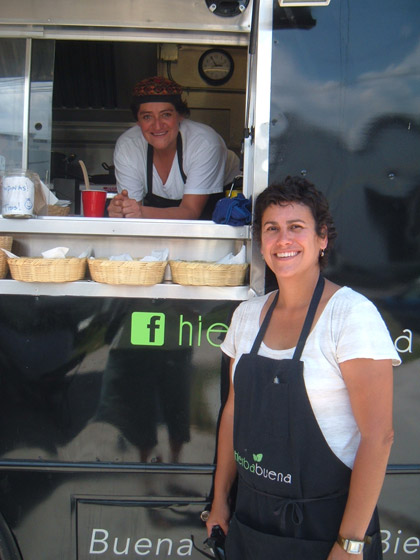
Jennifer
|
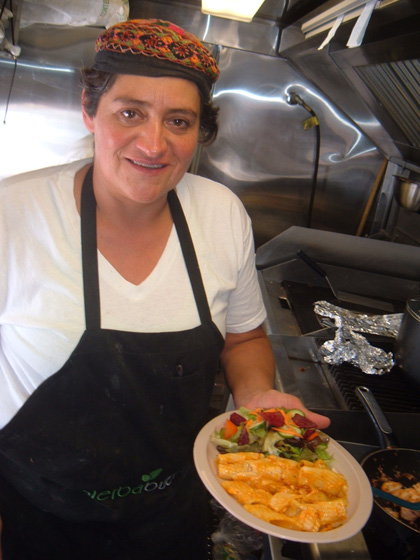 |
|
I helped my friend to open her restaurant, La Lola, in 1997 in San Miguel on Ancha San Antonio where the Sri Lankan restaurant used to be. The chef, I wasn't cooking at that time, was the former chef of Sierra Nevada so when he came to work with us many people were not very happy, "You stole him." He wanted more freedom. We had a lot in common. He wanted to cook with us. As a chef, it's crazy art, but finally it is art. It comes completely from your creativity, your mood, the things you are looking for yourself. In art if it's complicated, no one is going to buy it. If it's simple, no one is going to buy it. It's the same thing with cooking, sometimes you can make something simple or sometimes complicated, and sometimes the understanding is difficult.
That experience was great, but it was more for tourists. But it was just for certain people, a small public, because of the prices and the kind of food, everything was salmon and filet, a bit more sophisticated. Next year, after that experience, in 1998, I opened a small restaurant called La Fonda, Mexican food, simple, with the roots of my grandmother. I was cooking maybe 20% of the things. I ran the restaurant. And that was really my first restaurant.
Then I opened in a new location and I stayed there 3 years. Then we moved to a second location in front of Parque Juarez and there I cooked more. Now that I think about it, I wasn't afraid, but still I wanted to present my recipes to someone who really cooked. Then again I needed to move out. I moved to a third location and when I opened that one I said, "Oh I'm going to start cooking. All the recipes I have I'm going to start interpreting them myself." That restaurant was on San Antonio and Canal. I was there for 3 years. People know me first from La Fonda, but I started cooking in that location.
|
|
Then I traveled for one year, working and cooking, also, but I was more confident so I was cooking by myself. I went to Spain for 3 months and I worked with a friend in his little project. It was a food car actually, that's when the idea of a food car became romantic too me, I thought "Oh, it's fun." They call it "el mobile," very Spanish. And I started doing cooking classes and I went to San Francisco and did classes there. And then I was in Santa Cruz and Los Angeles, traveling with friends, doing cooking classes. People invited me to their house to do cooking classes. And that's what I did that year. Then I came back and started doing cooking classes here. My first profession is as a teacher, so I am a good teacher. I like to show things to people. I like to share culture. I like to share things that are related to that. I'm so used to that. I come from a large Mexican family where everyone gets together to cook and then to eat and then to drink and then to dance. I like that. So that classes were great. Cooking is very attached to the ground, to the earth, because that's where it comes from. But it's also spiritual.
|
|
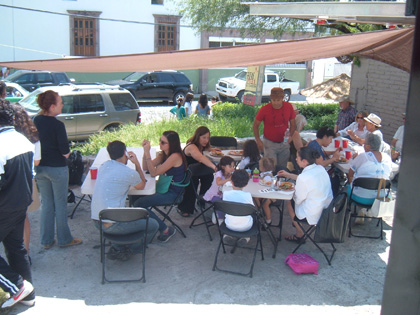 |
|
People ask me the menu, "What's going to be your menu this week?" I say, I don't know. I can tell you tomorrow but I can't tell you Friday. It's almost about the mood that I'm in and what I like to do that day and what things I have in the refrigerator. I don't like to waste, I recycle things. You just create a dish from what you have. It's part of my culture. It's great for people to have their own herbs and plants that they can just cook. It doesn't need to be a specific recipe, because that's difficult. If you have a restaurant or a special night cooking for your friends then you may stick to a recipe, but daily it's very simple. You try to understand what goes together with what. You just follow the rhythm.
Dining out can be difficult for a person who cooks, who maybe wants to find something different. If you ask me where do I go to eat, I would not respond to that, because it's difficult. If I'm in a certain mood, then maybe that's easier to find, but if I want something special, I'll do it myself. San Miguel has been has focused on tourism and many restaurants, say in downtown, they cook only for tourists, whether its Mexican or America, or international. There are a couple country-specific cuisine places, and I guess it's the mentality, they want to be the same, consistent, so that when people come back to town they'll find the same thing again and again.
What does a local want? What do we want to experience? Not many think that way.
|
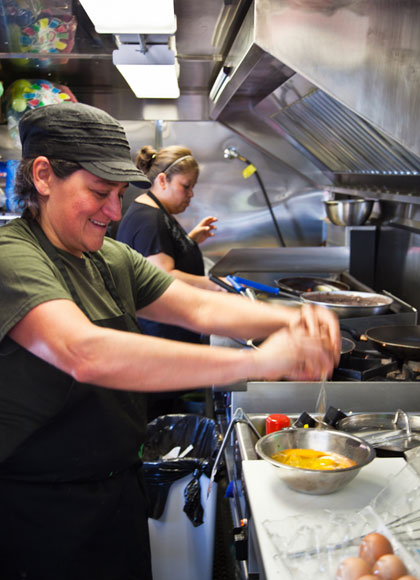
photo by Kate McKenna |
|
I have always been a revolutionary. I brought the first "official" film festival here [San Miguel Cinema Fest, in 1997]. I opened the first gay bar, La Lola. The cooking was great, it was a high-class restaurant, but open to everyone. At that time the foreign community was fine with it but the locals were not as much. That's normal. Everyone in the world there are gay people. So it's not a big thing. I've always tried to bring new things to San Miguel and the food truck is the new thing.
1996 is when I came permanently to San Miguel. I used to work for Televisa and Videovisa. I started there when I was really young, when I was 19-26. That's when I went to Spain for the first time, as a representative of the company in Europe. My job was to watch movies and buy the rights for Mexico. It was in the golden times of Mexico investment in culture and art. There were high budgets in the government and private companies to promote art. Of course I went to all the film festivals, Berlin Cannes Milan, in the US. I experienced a lot of festivals. My mother works in the film industry so I got to travel with her a lot and then we worked together. I used to watch all the films and chose them and she'd go back and negotiate them monetarily. We were a good team.
My parents moved to San Miguel three years ago. I'm happy that I've been able to reconnect because when you are young and you live with your parents in their house it's different. It's only when everything turns to a different moment, when you're an adult, that you really have a chance to enjoy your parents. When you develop your life, your interests, your craziness, when you went to search the world and when you have the information of the world is when you have a chance to maybe understand your parents in a different way. They came to town to live here when they retired and that's also the end of a cycle, the professional process. I was here in my process after seeing the world and that's when we could reconnect. We are not only parents and kids we are men and women.
|
| I met Jennifer 3 years ago. I was doing cooking classes at that time and she helped me market the cooking classes so we got to know each other better. One day I told her I had the idea of a food car from Europe and she said, "no, that's a food truck." So we went to the States and we stopped in Austin and she showed me the culture of the food truck in the States. That's when I said, oh, that would be great. And I didn't want to make a food truck with tacos. Mexico City has 2 or 3 food trucks, alternative different kind of things and the others are taco trucks.
Hierbabuena food truck is something I've wanted to do always. When I had the last restaurant location I wanted to expand my territory and offerings and my information and learning about different ingredients and everything. I was ready for the next step, to develop some other things that I had been interested in. Actually right now I have been appealing to that with the truck. And I have another interesting project that I will tell you about later. I guess things happen when you need them to happen, Not before not after, when you're ready.
|
|
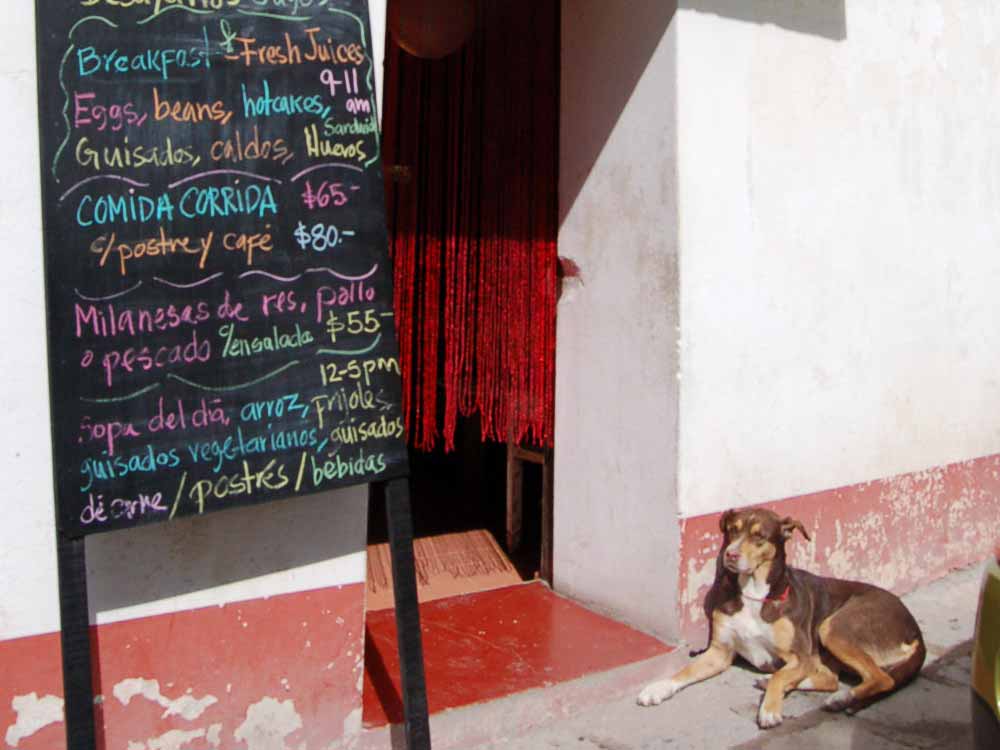
Trompa outside La Fonda |
Our truck is a girl and her name is Rosita. We call her Rosita Hierbabuena Green-Posner. I picked up the idea in 2006 when I closed my third location. I don't own a building. It's so complicated to be renting and moving all the time. I thought, well, the food truck is great because people just follow you. You tell them where you will be and they just follow and understand that your business is like that. Because I have so many other interests and I want to have time free to do them, and because the choice of food in San Miguel is wide, I offer my 3 days a week. It's good because people can come to me and then go to other places, too. And I have time to do the other things I'm interested in. The truck is more according to my personality. It's not like, "Ok, here is the menu." It's like, "Oh, the food truck is coming. Let's see what's on the menu today."
I go to the organic farms and see what is fresh. From there I build my menu. So it's really very local and it's very in season and it's what I want. Of course, I need to do balance, because there are people that want something on a permanent basis knowing that they will always find what they want when they come again and again. Then other people want something new each time. So the regular we have now, because of the crowd, is pizzas. It's more for the American people, but kids love it, and now since the school across form us is in session, that is important. Which is kind of a blessing of the universe, because when we started working there [Stirling Dickinson and Portrero] we didn't know that there would be a school [Academia Internacional] opening right there. We are there Monday, Wednesday and Friday from 10-4 doing breakfast and lunch. We get to our clients. We provide to the teachers at the school and the kids and mostly for the kids that stay after school they come for the chicken quesadillas, the girls like the chicken quesadillas, the boys like the pizzas.
|
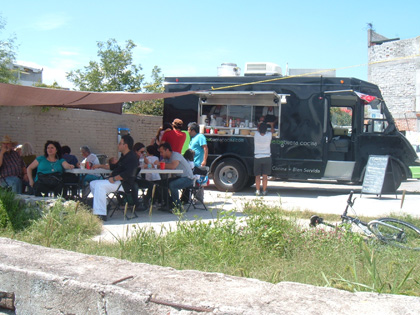 |
|
The beauty of the difference between the Fonda (which was a Mexican restaurant, so I had to do Mexican cuisine) and the food truck is the flexibility of your profile. What kind of food? We call it Cocina Mobile Gourmet. It's not going to be just tacos, fried tacos. It's going to be something with more ingredients, something gourmet. So yesterday I had a Mediterranean plate which was hummus, tabouli, quinoa, salad, and lamb brochettes. Then I had another dish that was couscous with lamb, because I had a lot of lamb and then I had the quesadillas and the pizzas and corn soup and everyone likes that. Then I had a Mexican dish, arrachera with guacamole and all that.
It's more casual too, people come to eat at the food truck without expectations, you go there to see what you're going to find. People ask for beer and I say, no, we don't have beer but there's a little store over there and you can get a beer there and drink it here; there's no problem. They are more open to get what they can. For all the people who would come from the restaurant, its not so stressful, it's casual, its plastic or recyclable materials and paper and so it's something that's easy for everyone.
|
|
I have had clients that bring wine, maybe a really expensive wine, and they don't mind drinking it in paper glasses. They aren't expecting fancy glasses, even if it's a nice wine. I've been doing chile nogada on Fridays. That's a great thing about having Jennifer as a partner. Jenifer does the marketing. She's very good at it. That's her profession. She markets and markets and markets and we have 30 orders for this weekend!
|
|
Yesterday someone came up to us to make a reservation for four people and asked, do you have wine and I said no but you can bring your own. Ok. I said, I can give you cups here, but bring your own wine. And he's like, oh yah! I'm going to bring this dry white wine Gavi di Gavi, an Italian wine, because your name is Gaby and it's a great grape for this kind of dish. So that's what I'm saying, people don't mind having a fancy wine in a paper cup in a food truck. And they're going to have the chiles nogada and they're amazing. They're coming and they order and they say what hour they're coming so I have a count. And now we have 30 orders plus another 20 for walk in people. That's all between 12-4 for the lunch. That's another secret that I found out after all my years with restaurants. Why be open 6 or 7 days when your customers just come three days and in 4 or 5 hours, why do you have to be open 8 or 9 hours?
It's the mentality in Europe right now, big companies who make cars like Mercedes say, ok, we have shifts of 8 hours and in those 8 hours we produce 2000 cars but we can't sell that many cars, we can only sell 1000. So we keep paying people for the 8 hours, but they're just going to come and work 5, because we can't sell everything otherwise. There is only place here that has people Monday to Sunday all hours of the day.
It's the same that happens to me; it's my vision, why have all this big offering when you can have a small offering with more consistency. Otherwise it's too much stress, and people start drinking.
That new proposal that we have with the food truck its more humane but it's still a lot of hours because we start at 730am preparing food and when we're closing afterwards I need to be around and organize it all, checking out everything, then make sure that the truck is off, whatever. By the time I leave it's often 730pm. That's twelve hours, instead of sixteen; it's twelve or maybe ten, and it's only three days a week instead of seven. Living in a community like here San Miguel with not so many people and a lot of restaurants, why have a place 24/7? I think I'm learning.
|
|
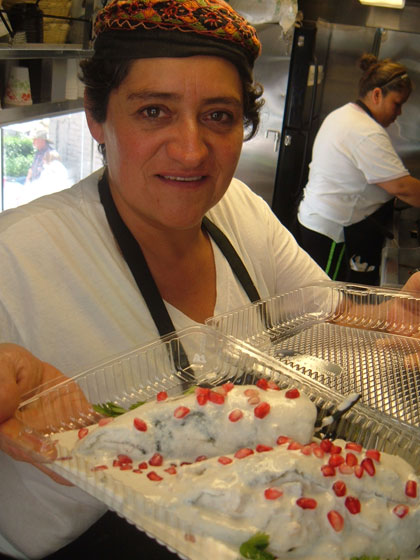 |
|
Friday, Sept. 14 is the last day for Chile Nogada at the truck.
Contact, Catering, Menus (updated 2-3 times/week) and Reservations: www.hierbabuenacocina.com. Chiles en Nogada: Learn more about Mexico's tri-colored national independence dish at Wikipedia.
.
|
|
|
|
|
|
|
|
|